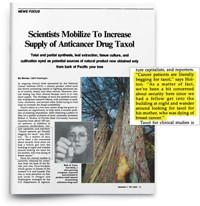Advertisement
Grab your lab coat. Let's get started
Welcome!
Welcome!
Create an account below to get 6 C&EN articles per month, receive newsletters and more - all free.
It seems this is your first time logging in online. Please enter the following information to continue.
As an ACS member you automatically get access to this site. All we need is few more details to create your reading experience.
Not you? Sign in with a different account.
Not you? Sign in with a different account.
ERROR 1
ERROR 1
ERROR 2
ERROR 2
ERROR 2
ERROR 2
ERROR 2
Password and Confirm password must match.
If you have an ACS member number, please enter it here so we can link this account to your membership. (optional)
ERROR 2
ACS values your privacy. By submitting your information, you are gaining access to C&EN and subscribing to our weekly newsletter. We use the information you provide to make your reading experience better, and we will never sell your data to third party members.
Pharmaceuticals
Cancer Fighters From The Sea
Natural Products: Sponge molecules isolated and synthesized for drug trials
by Bethany Halford
June 24, 2013
| A version of this story appeared in
Volume 91, Issue 25
By scouring the oceans for disease-fighting molecules, researchers have identified two new anticancer compounds. Isolated from a sea sponge, the compounds represent a new class of the natural products called polyketides, many of which have biological activity. Because it’s not possible to extract sufficient amounts of the molecules from the sponges, the researchers also devised chemical syntheses that allowed them to make enough material to initiate clinical trials on one of the substances, known as PM060184 (J. Am. Chem. Soc. 2013,DOI: 10.1021/ja404578u).
Looking for organisms with sophisticated chemical defenses, scientists from the Spanish biopharmaceutical firm PharmaMar plucked the sea sponge Lithoplocamia lithistoides from waters off the coast of Madagascar in 2005 and tested its extracts for cancer-fighting compounds. Two polyketides isolated from the extracts proved particularly potent at killing human cancer cells in a petri dish. The molecules appear to interfere with microtubules, which are structures that are key to cell division.
The researchers determined the structures of PM060184 and its cousin, PM050489, which has chlorine in place of hydrogen at one spot in the molecule. They developed syntheses for each one, in 33 and 35 steps, respectively, so the two compounds could be made in multigram quantities.
The syntheses construct each half of the molecules separately, so that the longest linear sequence is 18 steps. Long syntheses are not unheard of in the pharmaceutical realm. Eisai’s anticancer drug Halaven (eribulin mesylate), for example, requires 62 steps to make.
PM60184 is currently being tested in clinical trials for safety and efficacy.
Ian Paterson, a polyketide expert at Cambridge University, says that “while these are still early days, it is hoped that a successful anticancer drug emerges from this work and it stimulates further research in marine natural products for drug discovery.”






Join the conversation
Contact the reporter
Submit a Letter to the Editor for publication
Engage with us on Twitter